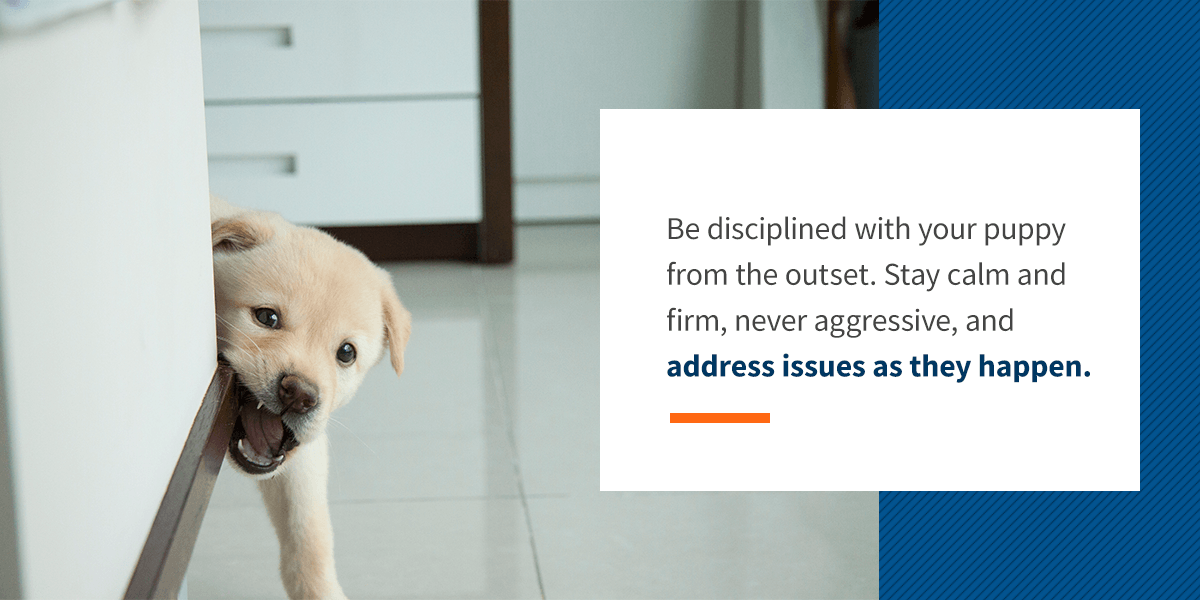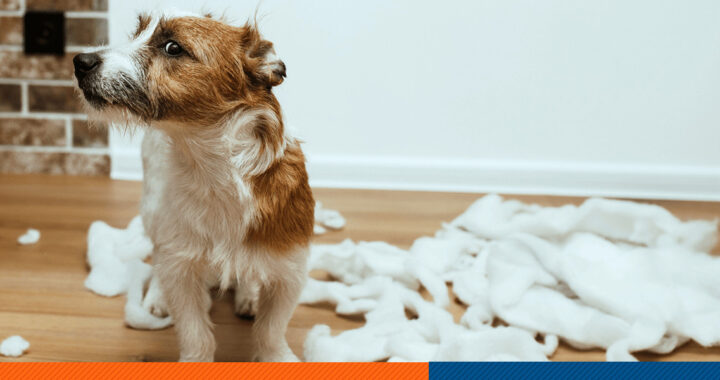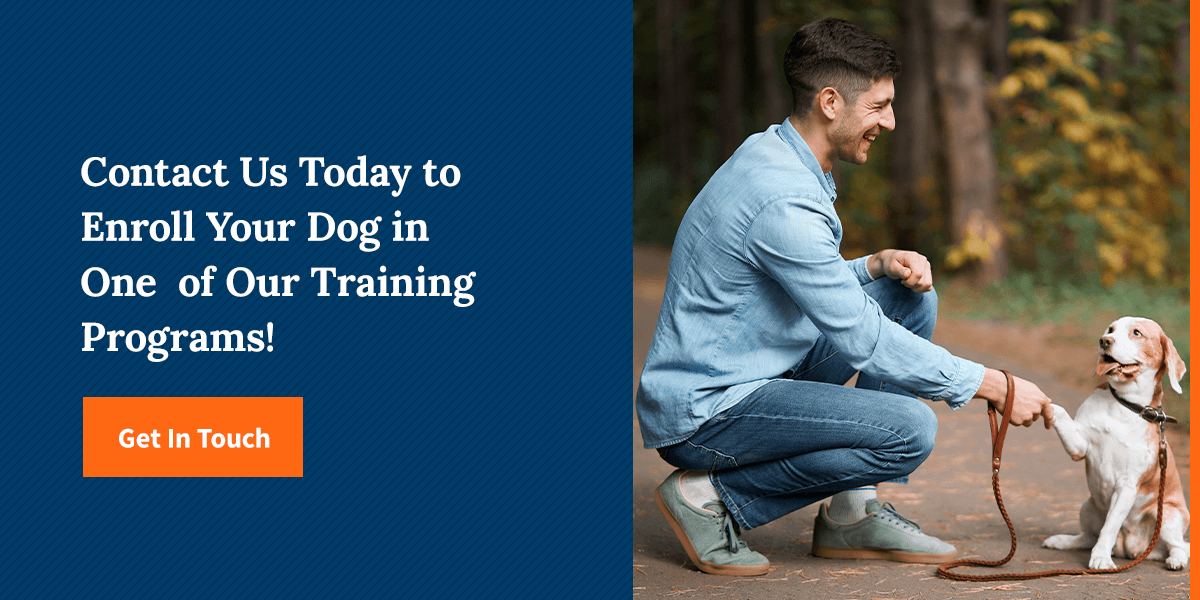Table of Contents
- What Are Common Behavioral Issues for Dogs?
- How to Correct Bad Dog Behavior
- How to Address Behavioral Issues in Dogs
- Contact Us Today to Enroll Your Dog in One of Our Training Programs!
In the United States, 65.1 million households have a dog, and 56% of dog owners report their dogs are naughty — that’s a lot of mischievous dogs. Bad behavior can impact your bond with your dog, resulting in destroyed belongings, unhappy pets and frustrated owners.
Learning how to correct bad dog behavior starts with knowing how it began. Once you identify the cause, you can correct the symptom. Your dog’s behavior might be more common than you think, and you can resolve it with a little help.
What Are Common Behavioral Issues for Dogs?
Bad dog behavior comes in many packages, and 85% of dogs are estimated to exhibit at least one problem behavior. Some problem behaviors are a little obscure, but many are common challenges for pet owners across the country, including:
- Excessive barking and whining: Barking and whining are part of a dog’s language, but when they take it to extremes, it can be highly disruptive.
- Chewing: Dogs naturally explore their environments with their mouths. They don’t know what items are allowed in their mouths, which can lead to many damaged pairs of shoes.
- Nipping and biting: These behaviors are common in puppies and younger dogs and are often due to overexcitement. As your dog matures, however, nipping and biting can quickly become dangerous.
How to Correct Bad Dog Behavior
Understanding what bad dog behaviors mean is essential to curtailing them. We’ve compiled some of the most common bad behaviors and provided a quick overview of what the causes could be and how to fix them.
How to Stop Excessive Whining
Whining can be many things — a greeting, an appeasement or sign of submission, a sign of pain, or a plea for attention. Your first step is to determine what triggers your dog’s behavior. Take the following steps to remove whining from your dog’s vocabulary:
- Visit the vet: Take your dog to the vet for a checkup to eliminate the possibility of physical pain as a cause.
- Listen: Pay attention to the pitch and sound of your dog’s whine to see if you can identify different sounds for different things. “I want something” could sound completely different from “I’m excited to see you,” for example.
- Approach carefully: Be calm and careful if you think the whining comes from pain or anxiety. The whining can turn into snapping or aggression if your dog feels threatened.
- Stay positive: Punishing or yelling at your dog will only confuse them and worsen the behavior.
- Consider the cause: Look at the situation objectively and try to identify the trigger for the whining. If it’s you coming home from work, it could be excitement. If your dog whines when they jump off the couch, it could be pain-related.
- Meet basic needs: Whining can be a positive in some cases, like if your dog whines at the door when they need to go outside.
- Avoid encouragement: If your dog is whining because they want something, don’t encourage the habit by giving in right away. For example, if they whine for food, ask for a “sit” and reward them with the food when they quiet down.
- Start in puppyhood: A whiny puppy quickly becomes a whiny dog. Avoid relenting in the puppy phase and redirect your dog’s attention instead.
How to Stop Destructive Dog Chewing
Chewing is one of the most frustrating of all problem behaviors. Try these tips to preserve your belongings:
- Remove temptation: If you don’t want your dog to chew your slippers, close them in the cupboard. If your dog is stealing the toilet roll, close the bathroom door. Set your dog up for success.
- Give your dog appropriate toys: Any toy you give your dog should differ from household items you want to keep intact. For example, a toy shoe is a no-go.
- Up the exercise: Your dog could be chewing out of boredom, and exercise is the best cure.
- Make a trade: If you catch your dog chewing something they shouldn’t, trade with them for something appropriate until they pick up the habit.
- Change the taste: You can use several taste deterrents to make furniture and other items seem unappealing. You can also use organic home alternatives, like hot sauce or aloe vera.
- Stay positive: Yelling and punishing can cause more behavioral problems, like aggressively guarding resources. Focus on positive reinforcement.
How to Stop Your Dog From Biting
Dogs bite for many reasons, including fear, defensiveness, territoriality, hunting instinct and correction — disciplining other members of their pack. Biting is a behavior you must address immediately, and depending on the cause, getting professional help may be the kindest and safest alternative.
You can take specific steps in the meantime, including:
- Go to the vet: Biting can occur due to pain or discomfort. Eliminate these potential causes before modifying your dog’s behavior.
- Spay or neuter: Sterilizing your dog can reduce the risk of bite-related behaviors. Discuss this option with your vet during your checkup.
- Exercise and play: Reinforce the bond with your dog with calm exercise and play sessions. Avoid rough games, which can increase the risk of playful nipping.
- Go to training: Training is an effective way to establish yourself as the pack leader and teach your dog basic commands, which can diffuse a potentially volatile situation.
- Know the signs: Dogs often exhibit other behaviors before they resort to biting. Look for warning signs like growling, ears pinned back, retreating and yawning — a show of dominance.
- Substitute a toy: If your dog nips playfully, make the same trade you would for chewing and give them a toy.
- Yelp: Sometimes, communicating with dogs in their language makes a difference. Your dog may not know he is hurting you, and yelping can help them understand their limits.
- Consult a professional trainer: Don’t leave things to chance and risk a dangerous mistake. Contact your local dog training facility and explain your concerns. They will help you navigate this challenge before it becomes a severe issue.

How to Address Behavioral Issues in Dogs
Just like every dog is different, so is each problem behavior. Some behaviors require a unique approach, and a professional trainer is your most valuable asset in approaching these issues. You can also take some general steps at home to address behavioral problems:
- Set boundaries from the beginning: Be disciplined with your puppy from the outset. Stay calm and firm, never aggressive, and address issues as they happen.
- Reward good behavior: Be clear when your dog exhibits good behavior so they learn the difference between right and wrong.
- Focus on training: Positive, reward-based training is critical to tackling behavioral problems. It teaches your dog they get rewarded when they do what you ask and gives you the tools to refocus their attention.
- Get some exercise: Your dog is likely better behaved when tired, and good exercise also gives them adequate mental stimulation.
- Be consistent: If you want to remove a behavior, you must respond the same way every time it occurs. Allowing a behavior sometimes and then preventing it will only confuse your dog.
- Understand the behavior: You’ll be more successful in addressing a problem if you understand why it’s happening. Try to identify your dog’s triggers and respond calmly and positively. Never yell or resort to physical punishment.
Contact Us Today to Enroll Your Dog in One of Our Training Programs!
Lousy dog behaviors can be challenging, but with the right approach and compassionate training, you can address the root cause and take steps to restore a harmonious household. Off Leash K9 Training Maryland can help you manage bad behaviors correctly. Our compassionate, knowledgeable trainers have experience in various behavioral issues and have several training options to suit your needs, including private training sessions to give you and your dog individual attention.
Whether you have a puppy and want to instill the basics or an adult dog with a behavioral problem, we handle any age, breed and size. Contact us today to learn more, and let the bond with your dog be off-leash.


